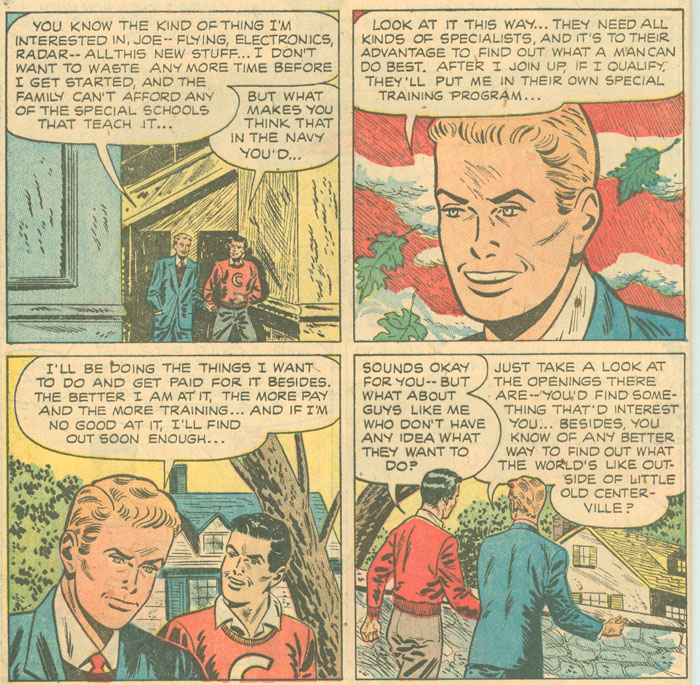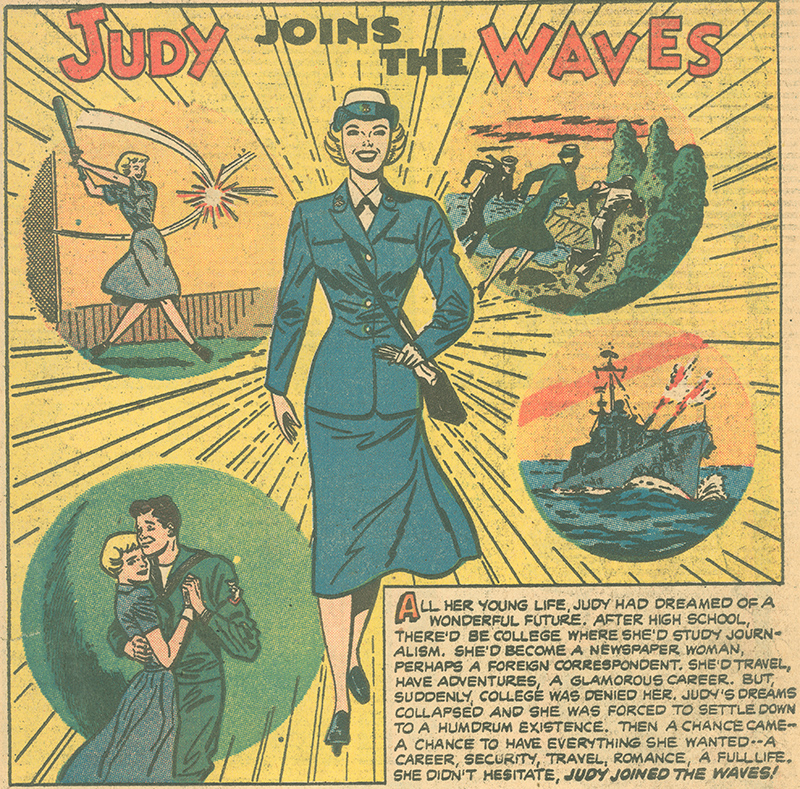The differentiation between the Navy’s conceptions and assumptions about men and women can perhaps best be seen in a comparison of the comics Dick Wingate of the United States Navy and Judy Joins the Waves. The 1951 women’s recruiting comic Judy Joins the Waves depicted the Waves (the US Navy’s female division) as a masculinized career-building route for women to pursue. The opening paragraph laid out Judy’s plans for the future: “After high school, there’d be college where she’d study journalism. She’d become a newspaper woman, perhaps a foreign correspondent. She’d travel, have adventures, a glamorous career…”[^] Judy lost hope in this future when her father lost his job, and she was forced to forego college and work at a ribbon counter.[^] Similarly, Dick Wingate’s story opens with his hopes of a technical career including, “…flying, electronics, radar – all this new stuff…,” but his family was unable to afford to send him to a training school.[^] The narratives and the presentation of Dick and Judy’s priorities and desires differed once they joined the Navy.
Immediately following Judy’s swearing-in ceremony, a male sailor (Jeff) walked through the Waves train car, and Judy and another woman, Sheila, immediately clashed over their attraction to the sailor.[^] The middle portion of the story is driven by her competition with Sheila for Jeff’s attention and affection. Dick, on the other hand, soon experienced the things he dreamed of – he is shown working on cutting-edge undersea radar technology.[^] Both Dick and Judy then have brushes with extra-military adventure and intrigue. Dick became engaged in a rogue smuggling and kidnapping investigation, and soon earned the attention of an attractive lounge singer who knew the kidnapped sailor’s whereabouts.[^] Dick came in and saved the sailor, and tackled the kidnapper just as he was about to shoot the lounge singer.[^]
Judy had a tamer adventurous arc. She realized that Sheila had been left behind on an island that was about to be shelled by US battleships.[^] Judy returned to the island, where she found Sheila incapacitated, and shouted for sailors to come rescue her. When Sheila discovered that it was Judy who saved her, she admitted to sabotaging Judy and Jeff’s relationship.[^] Sheila’s confession saved Jeff and Judy’s relationship, and the comic ended with Sheila and Judy walking arm-in-arm, singing the Waves’s song.[^]
While Judy had many of the same hopes and dreams as Dick, the comic focused on her relationship with Jeff and her rivalry with Sheila, rather than her training, experiences, or career prospects. The creators presumably felt that women would be more interested in a love story than a story about career success through the Navy. In many ways this presumption, along with the narrative throughout Judy Joins the Waves, aligns with the worldview that women may think they are interested in a career, but ultimately, they truly desire a husband and work in the domestic world.[^] The assumption that women could work in times of crisis or prior to getting married, but not afterwards, was popular amongst men, and was a source of tension following WWII when many women were forced out of the workplace when men returned from abroad. Women increasingly fought against this notion, citing their abilities in the workplace during the war.
The adventure arcs also illustrated some presumed gender capabilities and limitations. Both Dick and Judy saved a damsel in distress, but did so in different and ideologically revealing ways. Dick’s rescue required the use of force against a direct and dangerous opponent. Judy’s, on the other hand, was an escape from an impending disaster. Although Judy showed a great amount of courage by putting herself in harm’s way, she does not have to face down or defeat a foe. Furthermore, she was incapable of saving Sheila on her own, and had to yell for the male soldiers to come and carry her back. The comparison of these two are emblematic of the difference between male masculinity and female masculinity in the corpus of materials.
Related Sections
- Antifemininity
- Antifemininity - It's All in the Family!
- Antifemininity - Builders of Faith
- Antifemininity - Four Futures
- Antifemininity - Leatherhead in Korea
- Antifemininity - Mister Marine Corps
- Antifemininity - Pvt. Droop Has Missed the War!
- Antifemininity - This is Ann
- Antifemininity - Time of Decision
- Be a Bigwheel - Breadwinner - Dick Wingate in the US Navy
- Be a Big Wheel - Athletic & Physical Prowess - Dick Wingate in the US Navy
- Be a Big Wheel - Sexual Appeal and Adoration - Dick Wingate in the US Navy
- Be a Big Wheel - Sexual Appeal and Adoration - Judy Joins the Waves/a>
Primary Sources




